Quiz Answer Key and Fun Facts
1. After the extinction of the dinosaurs, many ecological niches were left vacant. This allowed small mammals to evolve into larger beings. What period of Earth's history does the Paleogene roughly cover?
2. Cetaceans are large aquatic mammals like whales, dolphins, and porpoises. Which group of mammals are they thought to share a common ancestry with?
3. Grass had been around since the late Paleozoic, but it took as long as the Oligocene for it to grow outside of woodland areas. What caused grass seeds to expand from the forests and grow on the prairies of the Earth?
4. The Mediterranean Sea is much smaller than its predecessor, the Tethys Sea. What caused the Tethys to shrink throughout the Paleogene?
5. Two continents that were once joined became separated during the Paleogene - the last two continents to break apart from each other. What were they?
6. The lineage of rhinoceros can be traced to one of the largest land-dwelling mammals that ever existed. With a name meaning "near the hornless beast", what was it called?
7. The Paleogene was inhabited by many species that looked like hybrids of modern day mammals. Yet there are some mammals, such as rodents and bats, that bear a solid resemblance to those of the period. Named after a mythological figure, what is the oldest known bat species ever found?
8. Cladistic analysis of mammals has largely been influenced by a quarry in Germany that was named after a prehistoric lake. Where have these well preserved Paleogene fossils been discovered?
9. During the Oligocene, a major event occurred that may have affected the global climate all the way to our present age. What was it?
10. Cats and dogs can trace their lineage back to a group of species that existed during the Paleogene. Among the first of the order Carnivora, they had a name that means "mother animal". What were they called?
Source: Author
albert11
This quiz was reviewed by FunTrivia editor
rossian before going online.
Any errors found in FunTrivia content are routinely corrected through our feedback system.

